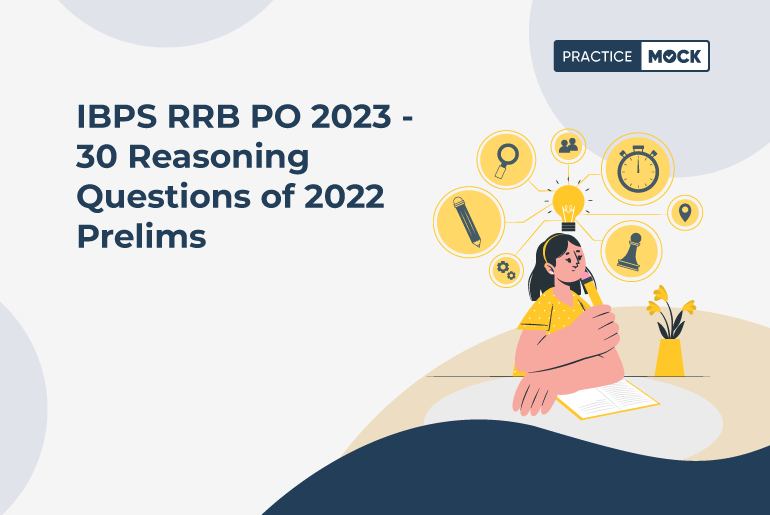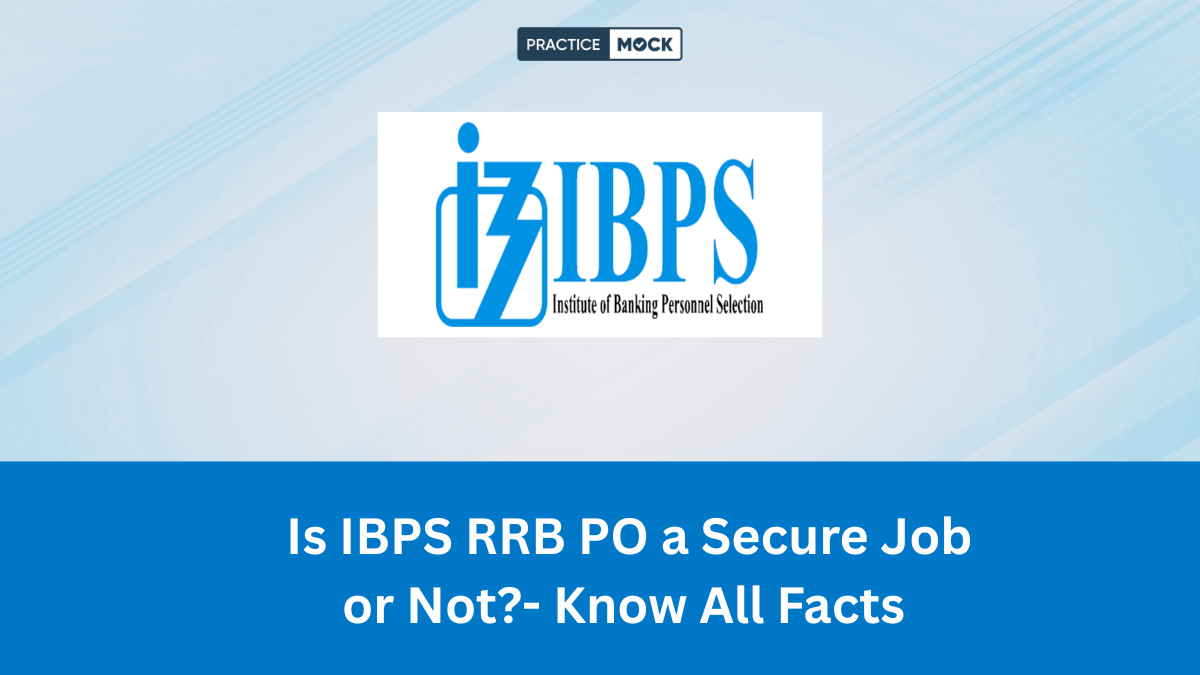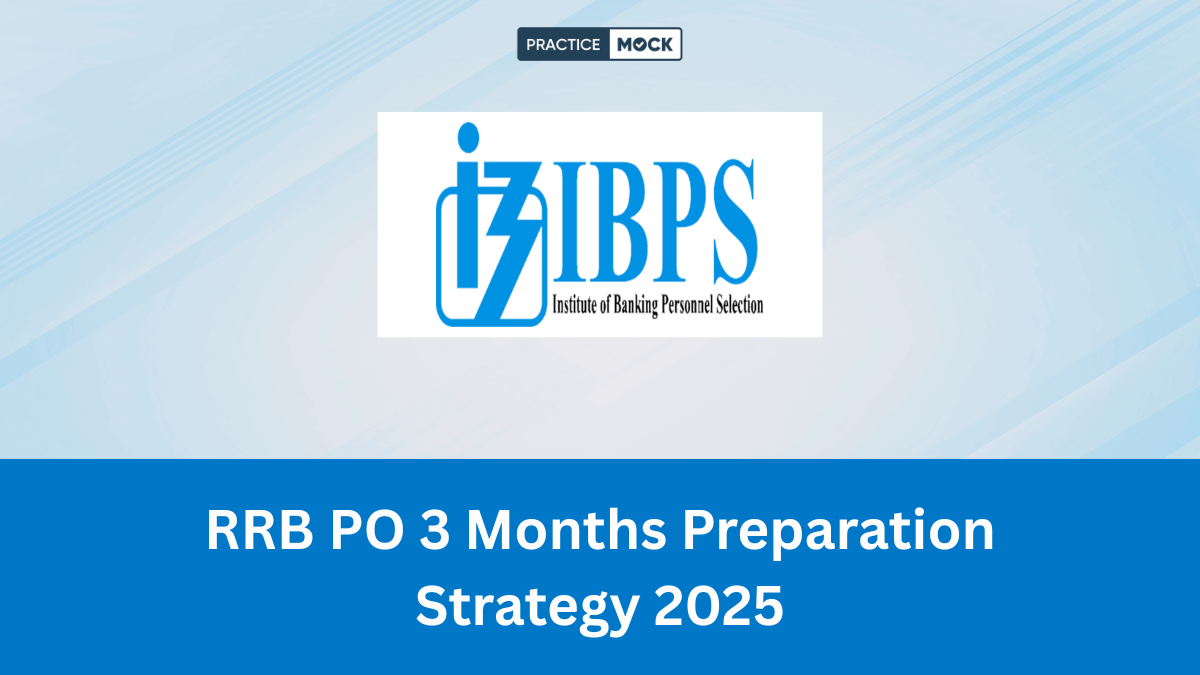

The tentative date of the IBPS Regional Rural Bank (RRB) PO Prelims 2023 is scheduled on August 5th 2023 while mains is planned on September 10th 2023. I hope you have already devised an effective plan for the exam. If not, get down to it now. Because any delay may cost you dearly. It is advisable to keep pegging away, while awaiting the next notification concerning exam dates and admit cards etc. Aspirants often ask for the previous year’s question paper, I am sharing 30 reasoning questions of IBPS RRB PO Prelims 2022. Before moving forward to the last year’s reasoning questions let us quickly have a sneak peek at the exam pattern.


IBPS RRB PO 2023 Exam Pattern
Both prelims and mains are consist of one MCQ type question papers. Here’s a list of subjects, time and marks allocated to each question. There is negative marking for each wrong answer in both prelims and mains.
Prelims
| Name of the test | Medium of Exam | No. of Questions | Maximum Marks | Duration |
|---|---|---|---|---|
| Reasoning | Hindi/English/Regional Language* | 40 | 40 | Composite time of 45 minutes |
| Numerical Ability | Hindi/English/Regional Language* | 40 | 40 | |
| Total | 80 | 80 |
Take a FREE Mock Test of IBPS RRB PO 2023 NOW!
Mains
| Name of the Test | Medium of the exam | No. of Questions | Maximum Marks | Duration |
|---|---|---|---|---|
| Reasoning Ability | Hindi/English | 40 | 50 | Composite time of 120 minutes |
| Numerical Ability | Hindi/English | 40 | 50 | |
| General Awareness | Hindi/English | 40 | 40 | |
| English Language | English | 40 | 40 | |
| Hindi Language | Hindi | 40 | 40 | |
| Computer Knowledge | Hindi/English | 40 | 20 | |
| Total | 200 | 200 |
Previous Years’ Reasoning Questions (Memory-Based)
Directions: In each question below are given two or more statements followed by two conclusions numbered I and II. You have to take the given statements to be true even if they seem to be true even if they seem to be at variance with commonly known facts. Read all the conclusions and then decide which of the given conclusions logically follows from the given statements disregarding commonly known facts.
1. Statements:
- All triangles are squares.
- No square is a rectangle.
- Some circles are rectangles.
Take a FREE Mock Test of IBPS RRB PO 2023 NOW!
Conclusions:
I. At least some circles are not squares.
II. No rectangle is a square.
A. if only conclusion I follows.
B. if only conclusion II follows.
C. if either conclusion I or II follows.
D. if neither conclusion I nor II follows.
E. if both conclusions I and II follow.
Directions: In each question below are given two or more statements followed by two conclusions numbered I and II. You have to take the given statements to be true even if they seem to be true even if they seem to be at variance with commonly known facts. Read all the conclusions and then decide which of the given conclusions logically follows from the given statements disregarding commonly known facts.
2. Statements:
All triangles are squares.
No square is a rectangle.
Some circles are rectangles.
Conclusions:
Take a FREE Mock Test of IBPS RRB PO 2023 NOW!
I. No triangle is a rectangle.
II. Some rectangles are not circles.
A. if only conclusion I follows.
B. if only conclusion II follows.
C. if either conclusion I or II follows.
D. if neither conclusion I nor II follows.
E. if both conclusions I and II follow.
Directions: In each question below are given two or more statements followed by two conclusions numbered I and II. You have to take the given statements to be true even if they seem to be true even if they seem to be at variance with commonly known facts. Read all the conclusions and then decide which of the given conclusions logically follows from the given statements disregarding commonly known facts.
3. Statements:
All bottles are cups.
Some plates are cups.
No plate is a spoon.
Conclusions:
Take a FREE Mock Test of IBPS RRB PO 2023 NOW!
I. All spoons are not cups.
II. All cups being plates is a possibility.
A. if only conclusion I follows.
B. if only conclusion II follows.
C. if either conclusion I or II follows.
D. if neither conclusion I nor II follows.
E. if both conclusions I and II follow.
Direction: In each of the following questions two statements are given and these statements are followed by two conclusions numbered 1 and 2 You have to take the given two statements to be true even if they seem to be at variance from commonly known facts. Read the conclusions and then decide which of the given conclusions logically follows from the two given statements, disregarding commonly known facts.
4. Statements:
Some classes are schools.
Some schools are colleges.
All colleges are universities.
Take a FREE Mock Test of IBPS RRB PO 2023 NOW!
Conclusions:
I. Some colleges are classes
II. No university being classes is a possibility.
A. If only I follows
B. If only II follows
C. If either I or II follows
D. If neither I nor II follows
E. If both I and II follow
Direction: In each of the questions below are given four statements followed by three conclusions numbered I, II and III. You have to take the given statements to be true even if they seem to be at variance from commonly known facts. Read all the conclusions and then decide which of the given conclusions logically follows from the given statements disregarding commonly known facts.
5. Statements:
All chairs are fire.
Some fires are winds.
All winds are nets.
Some nets are clocks.
Take a FREE Mock Test of IBPS RRB PO 2023 NOW!
Conclusions:
I. Some clocks are winds.
II. Some nets are fires.
III. Some winds are chairs.
A. None follows
B. Only I follows
C. Only II follows
D. Only III follows
E. Only II and III follow
Direction: (6 – 10) : In the following question, some statements are followed by some conclusions. Assuming the given statements to be true, find which of the following conclusions follow the given statements and choose appropriate answer choice.
6. Statements:
No doctor is engineer.
Some engineers are teachers.
Some teachers are bankers.
Take a FREE Mock Test of IBPS RRB PO 2023 NOW!
Conclusions:
I. All engineer being banker is a possibility.
II. There is a possibility that some bankers are doctors.
A. If both conclusions I and II follow
B. If only conclusion II follows.
C. If conclusion Either I or II follows.
D. If only conclusion I follows.
E. If conclusion Neither I nor II follows.
7. Statements:
No doctor is engineer.
Some engineers are teachers.
Some teachers are bankers.
Take a FREE Mock Test of IBPS RRB PO 2023 NOW!
Conclusions:
I. Some teachers are doctors.
II. No teacher is a doctor.
A. If only conclusion I follows.
B. If only conclusion II follows.
C. If both conclusions I and II follow.
D. If conclusion Neither I nor II follows.
E. If conclusion Either I or II follows.
8. Statements:
Some chocolates are candies.
Some toffees are gems.
Some candies are gems.
Take a FREE Mock Test of IBPS RRB PO 2023 NOW!
Conclusions:
I. At least some gems are chocolates.
II. All gems being chocolates as well as candy are a possibility.
A. If both conclusions I and II follow
B. If only conclusion II follows.
C. If conclusion Neither I nor II follows.
D. If conclusion Either I or II follows.
E. If only conclusion I follows.
9. Statements:
Some chocolates are candies.
Some toffees are gems.
Some candies are gems.
Take a FREE Mock Test of IBPS RRB PO 2023 NOW!
Conclusions:
I. At least some gems are chocolates.
II. All candies are toffees.
A. If only conclusion II follows.
B. If both conclusions I and II follow
C. If conclusion Either I or II follows.
D. If conclusion Neither I nor II follows.
E. If only conclusion I follows.
10. Statements:
Some tables are chairs.
No chair is a box.
Some boxes are drawers.
Take a FREE Mock Test of IBPS RRB PO 2023 NOW!
Conclusions:
I. Some drawers are tables.
II. No table is a drawer.
A. If both conclusions I and II follow
B. If conclusion Neither I nor II follows.
C. If conclusion Either I or II follows.
D. If only conclusion II follows.
E. If only conclusion I follows.
Direction: In each of the questions below, statements are given followed by two conclusions numbered I and II. Read all the conclusions and then decide which of the given conclusions follow from the given statements.
11. Statements:
Some Ram is Ravi.
Some Raman is Ravi.
All Ravi are Raju.
No Raman is Rohan.
Take a FREE Mock Test of IBPS RRB PO 2023 NOW!
Conclusions:
I. All Rohan are Raju is a possibility.
II. No Ravi is Rohan.
A. only I follows
B. only II follows
C. either I or II follows
D. neither I nor II follow
E. both I and II follow
Direction: The following question consists of four statements followed by two conclusions. Consider the statements to be true even if they vary from commonly known facts and find out which of the conclusions logically follow(s).
12. Statements:
Some problems are easy.
All tough are easy.
All puzzles are problems.
Some tough are different.
Take a FREE Mock Test of IBPS RRB PO 2023 NOW!
Conclusions:
I. At least some easy are different.
II. Some tough are puzzles.
A. Only conclusion I follow.
B. Only conclusion II follow.
C. Either conclusion I or II follows.
D. Neither conclusion I or II follows.
E. Both conclusion I and II follows.
Direction: The following question consists of four statements followed by two conclusions. Consider the statements to be true even if they vary from commonly known facts and find out which of the conclusions logically follow(s).
13. Statements:
All seconds are minutes.
All minutes are hours.
No month is hour.
All days are months.
Take a FREE Mock Test of IBPS RRB PO 2023 NOW!
Conclusions:
I. Some hours are days.
II. Some months which are days being seconds is a possibility.
A. Only conclusion I follow.
B. Only conclusion II follow.
C. Either conclusion I or II follows.
D. Neither conclusion I or II follows.
E. Both conclusion I and II follows.
Direction: In question, some statement are given followed by some conclusions. Read all the conclusions and decide which of the given conclusion follow the given statements.
14. Statements:
Some Rupee are Dollar.
All Dollar is Yen.
Some Yen is Yuan.
No Renminbi is Dollar
Take a FREE Mock Test of IBPS RRB PO 2023 NOW!
Conclusions:
I. All Yuan are Renbinbi is a possibility.
II. All Renbinbi are Rupee is a possibility.
A. Only I follows
B. Only II follows
C. Either I or II follows
D. Neither I nor II follow
E. Both I and II follow
Direction: In question, statement are given followed by two conclusions. Read all the conclusions and decide which of the given conclusion follow the given statements.
15. Statements:
Some White are Blue.
All Blue are Red.
No White is Green.
Some Red are Orange.
Take a FREE Mock Test of IBPS RRB PO 2023 NOW!
Conclusions:
I. No Green is Blue.
II. All Blue being Green is a possibility.
A. Only I follows
B. Only II follows
C. Either I or II follows
D. Neither I nor II follow
E. Both I and II follow
Direction (16 – 20): Read the following information carefully to answer the questions based on it. In a certain coding language,
‘Tell someone they matter’ is written as ‘BH PR AL MN’;
‘Someone at the door’ is written as ‘TS KD WC BH’;
‘Tell door closer adjustment’ is written as ‘AL CN UV KD’;
‘Adjustment to the matter’ is written as ‘PR EG TS CN’.
Take a FREE Mock Test of IBPS RRB PO 2023 NOW!
16. What is the code for ‘Adjustment’?
A. UV
B. EG
C. KD
D. CN
E. None of these
17. What is the possible code for ‘Close the matter’ in the same coding language?
A. UV PR TS
B. MS PR TS
C. UV PR KD
D. TS MS UV
E. None of these
Take a FREE Mock Test of IBPS RRB PO 2023 NOW!
18. Which word represents the code ‘WC’?
A. The
B. Door
C. Someone
D. At
E. None of these
19. What is the code for ‘The closer’?
A. CN TS
B. WC EG
C. UV TS
D. UV EG
E. None of these
Take a FREE Mock Test of IBPS RRB PO 2023 NOW!
20. What is the code for ‘At to’?
A. UV WC
B. TS EG
C. WC CN
D. EG WC
E. None of these
Direction (21 – 25): Study the following data carefully and answer the questions accordingly.
‘members best interact together’ is coded as ‘my ff fn sp’,
‘discharge option best together’ is coded as ‘fn xf ky sp’,
‘members best discharge entry’ is coded as ‘xf fn ff ra’,
‘interact best staff information’ is coded as ‘hu my fn bv’.
Take a FREE Mock Test of IBPS RRB PO 2023 NOW!
21. What is the possible code for ‘information discharge’?
A. fn bv
B. my hu
C. hu ky
D. bv xf
E. None of these
22. What is the code for ‘members entry together’?
A. sp ff xf
B. ff fn ky
C. ra sp ff
D. fn sp my
E. Cannot be determined
Take a FREE Mock Test of IBPS RRB PO 2023 NOW!
23. What is the code for ‘option’?
A. fn
B. sp
C. ky
D. xf
E. None of these
24. What does ‘hu my’ stands for?
A. staff together
B. best information
C. interact information
D. staff interact
E. Cannot be determined
Take a FREE Mock Test of IBPS RRB PO 2023 NOW!
25. What does ‘ra xf ky ff’ stands for?
A. staff discharge members option
B. discharge entry best option
C. members entry discharge option
D. members best interact option
E. Cannot be determined
Direction (26 – 30): Study the information given below and answer the questions based on it.
In a certain code language,
‘Umesh was playing cricket’ is written as ‘po ki top ma’,
‘Ashish was playing tennis’ is written as ‘kop ja ki ma’,
‘those are playing volleyball’ is written as ‘ki nop sop ho’,
‘cricket and tennis’ is written as ‘po viz kop’
Take a FREE Mock Test of IBPS RRB PO 2023 NOW!
26. What is the code, used for the word ‘cricket’?
A. po
B. top
C. ma
D. ki
E. None of these
27. Find the code used for the word ‘volleyball’?
A. top
B. sop
C. ho
D. Can’t be determined
E. None of these
Take a FREE Mock Test of IBPS RRB PO 2023 NOW!
28. What would be the possible code for ‘Umesh loves tennis’?
A. kop ja top
B. top ma ja
C. top kop so
D. ki kop so
E. ki kop sa
29. What is the code used for the word ‘playing’?
A. ma
B. kop
C. ja
D. ki
E. None of these
Take a FREE Mock Test of IBPS RRB PO 2023 NOW!
30. Find the code used for the word ‘those’?
A. ki
B. top
C. sop
D. Can’t be determined
E. None of these
Takeaways
Previous years’ question papers help student assimilate the question pattern as well as the topics frequently asked. Aspirants may also try our FREE Mock Tests that come with the time constraint so that the candidate can take the mock test in an environment similar to exams. For any query you may shoot an email at info@practicemock.com or just hit up at 9319314079. Happy Prepping!
Recent Posts
NICL AO 2025 Notification | Pre-Recruitment Training Details
In this article, we have given detailed information about the NICL AO Pre-Recruitment Training which…
SBI PO Exam Self Preparation Tips- Know How to Crack SBI PO Without Coaching?
Crack SBI PO without coaching using expert tips, mock tests & free PDFs. Follow a…
IBPS Normalization Formula 2025, Check Method of Calculating Equipercentile Equating
Know the IBPS PO Normalization Process 2025. Check how Equipercentile Equating works across all shifts…
SSC CHSL Topic wise Tests: Attempt for Free & Boost Your Prep
This blog provided the SSC CHSL Topic-wise Tests. Candidates can attempt the tests for free.…
Previous Year’s Blood Relations Questions Asked in RRB PO Exam
Check previous year questions on blood relations asked in the RRB PO exam, solving techniques,…
SBI PO Mock Test Challenge 2025, Attempt Now to Ace Your Prep
Attempt the SBI PO Mock Test Challenge 2025 now! Boost your preparation, improve speed and…



